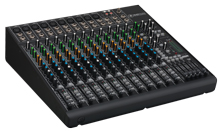

Mackie 1642 VLZ4 Review
Apr 23, 2014 2:45 PM, Reviewer: John McJunkin
A quiet, professional, and sturdy compact mixer
In the world of corporate audio, AV, and installed sound, we’re not concerned with saturated, fat, round tube tone. We leave the artistry and creativity to the studio people. Our concern is getting clean and clear audio so there’s no mistake as to what’s being heard. We want it undistorted, uncolored, and unimpeded by noise. For this reason, Mackie has been a popular choice. Its VLZ series of mixers, in particular, are known for being quiet and passing along that which was fed into them with very little in the way of undesirable nonlinearities. Mackie has now incorporated its Onyx mic preamplifiers into the VLZ mixer series, contributing even more to the delivery of a clean, clear signal. The new VLZ4 series features a total of eight mixers ranging from four to 32 inputs. I got my hands on a 1642 VLZ4 model and put it through its paces.
I would consider the entire line of VLZ4 mixers as compact because they feature faders with a 60mm throw, not 100mm. The 24- and 32-input versions are physically larger for obvious reasons, but I’m pleased that none of these mixers are huge. People who choose compact consoles do so very deliberately to get portability and a smaller physical footprint. I’m also pleased to see that some, including the 1642 I evaluated, are rackmountable. Each 1642 input channel features a 60mm fader, mute, solo, and bus assignment buttons, and a pan pot (balance control for the stereo line inputs represented by channel pairs 13-14 and 15-16).
Channels 1-8 feature three-band EQ: low shelf cornered at 80Hz, high shelf cornered at 12kHz, and mids sweepable from 100Hz to 8kHz. All three offer 15dB of boost or cut. Channels 9-16 (paired into four faders) have nearly identical EQ, with the exception of mids; rather than a single sweepable band, these channels feature two mid bands, centered at 400Hz and 2.5kHz, respectively, also granting boost or cut of 15dB. The mids all have a bandwidth of one octave. All 16 input channels have four auxiliaries; auxes 1 and 2 can be toggled between prefader and post-fader mode; 3 and 4 are permanently in post-fader mode.
Channels 1-12 offer an 18dB/octave high-pass filter that’s 3dB down at 75Hz, and all 16 inputs feature gain knobs with a range from -20dB to +40dB. Those numbers reflect the level of the line inputs—the range for the XLR mic inputs is 0dB to +60dB. The difference between the two could be described as a “virtual pad,” a very clever way of handling disparate levels, in my opinion. I really like that wide dynamic range; the capacity for a broad range of gain facilitates almost any signal source. The major upgrade from the VLZ3 to VLZ4 is the deployment of Mackie’s well-known Onyx mic preamps. All 16 inputs feature balanced 1/4in. TRS line-level inputs (stereo pairs for channels 9-16), and there are TRS-split inserts on channels 1-8. Stereo-paired RCA tape in and out jacks and two 1/4in. headphone jacks are also on the front panel.
The front panel also features a main mix fader and four faders controlling subgroup outputs. There are master knobs for auxes 1 and 2, and knobs for the mixer’s four stereo returns, along with pushbuttons for return bus assignment and soloing. A control room section features headphone, control room, tape in, and solo level knobs. Pushbuttons in this section determine which source feeds monitors: tape, subs 1-2, subs 3-4, or the main mix. A pushbutton can send the tape input to the stereo bus, and another determines whether solo mode is AFL or PFL. The same buttons adjust the stereo, 12-LED level meter display.
In addition to an IEC AC power inlet, power switch, and global phantom power switch, the rear panel features the mixer’s main stereo outputs—two XLR and two 1/4in. TRS jacks. An additional 1/4in. TRS jack provides a mono output as well, with a knob to adjust level. A pair of 1/4in TRS jacks represent inserts on the main output, and these are the only audio jacks on the rear panel that are not balanced. As a matter of fact, all of the remaining connectors on the rear panel are indeed balanced 1/4in. TRS jacks representing the four auxiliary sends, a stereo control room output, direct outputs from channels 1-8, subgroup outputs 1-8, and the mixer’s four stereo returns.
Mackie touts the VLZ as being super quiet, with the noise floor down at -86dBu with all faders at unity gain. The specs also proclaim a crosstalk spec of -82dBu, and the company publishes a total harmonic distortion spec of 0.0007 percent, referencing 1kHz at 35dB of gain. The company also promotes the idea that it’s built like a tank, with a steel chassis and RF rejection better than that of its predecessors. Another of the standout features that Mackie promotes is “high visibility, high contrast controls,” which I find to be important with any mixer but particularly so with compact mixers—the interfaces of which tend to be a little crowded.
I did not evaluate Mackie’s specs scientifically or objectively, but to my ear, the claim of being super quiet is absolutely true. This thing is dead quiet, a truly important attribute for corporate, AV, and installed sound. I plugged in a number of mics, including large-diaphragm condenser mics, and I was able to bring up the input gain so high as to literally hear street noise outside the building with the only significant noise coming from the mic’s electronics. I checked crosstalk on adjacent channels, and again, I would submit that the impressive -82dBu spec is honest—very little crosstalk with input signals at reasonable levels of gain. As to distortion, again, I would say that it is as low as Mackie says it is—another very impressive figure. Bottom line in this domain: The VLZ4 is very quiet and impressively linear.
As to other subjective attributes, I found the equalizers to be very good. The Q isn’t so narrow as to render the EQ too sharp but also not so wide as to yield sledgehammer results when a scalpel is what’s necessary. The fixed EQs placement works well both for human voice and musical instruments. The 75Hz HPF on the first 12 channels very effectively eliminates rumble, but the capacity to boost with the low shelf cornered at 80Hz still yields full low end. I also really like the clever and versatile options for routing the stereo returns, along with the capacity to solo them. For that matter, the direct outputs and subgroups also nicely facilitate multitrack recording, if that’s something you need to do. Mackie has a video showing VLZ mixers being thrown on the floor, stood upon, and even run over by a car. These mixers really are sturdily built and capable of withstanding the rigors of professional use.
Mackie’s products have evolved steadily over the years, and for certain applications, have now achieved the status of being truly solid and truly professional. In my opinion, the VLZ4 mixers are an excellent example of that. They’re vastly better than their predecessors, and absolutely ready for prime time. If you need a dead quiet, undistorted signal, and really sturdy build quality, I recommend that you consider the VLZ4 series.
PRODUCT SUMMARY
Pros: Quiet signal path, low distortion, sturdy build quality, controls quickly identifiable | Cons:The unavoidable crowdedness of knobs and buttons on compact mixers
Applications: Live sound, house of worship, gym, conference and boardrooms, video post, multimedia, broadcast
Price: $699.99
SPECIFICATIONS
Main Mix Noise
Main mix fader unity, channel faders down: –86.5dBu
Main mix fader@unity, channel faders@unity: –86dBu (90dB Signal to Noise Ratio, ref +4dBu)
Total Harmonic Distortion (THD)
Mic in to insert send: <0.0007% (1kHz @ 35dB gain, 20Hz–20kHz bandwidth)
Channel mute switch engaged: –82dBu
Channel gain knob down: –82dBu
Frequency Response
Mic input to main output (gain @ unity): +0, –1dB, 20Hz to 50kHz; +0, –3dB, <10Hz to >100kHz
Equivalent Input Noise (EIN)
Common Mode Rejection Ratio (CMRR – 1 kHz): better than –70dB
Maximum Levels
Mic in: +22dBu
All other inputs: +22dBu
Main mix TRS out and XLR out: +28dBu
All other outputs: +22dBu
Impedances
Mic in: 2.5 k
Channel insert return: 2.5kΩ
All other inputs: 10kΩ or greater
Tape out: 1.1kΩ
All other outputs: 120Ω
3-band EQ (Channels 1-8)
High Shelving: ±15dB @ 12kHz
Mid Peaking: ±15dB sweep 100Hz – 8kHz
Low Shelving: ±15dB @ 80Hz
Low Cut Filter: 18dB/octave, –3dB @ 75Hz
4-band EQ (Channels 9-16)
High Shelving: ±15dB @ 12kHz
High Mid Peaking: ±15dB @ 2.5kHz
Low Mid Peaking: ±15dB @ 400Hz
Low Shelving: ±15dB @ 80Hz
Low Cut Filter: 18dB/octave, –3dB @ 75Hz
John McJunkin is the principal of Avalon Podcasting in Chandler, Ariz., and produces and co-hosts a top-rated morning radio talk show in Phoenix. He has consulted in the development of studios and installations and provides high quality podcast and voice production services.










